For May’s Friday Late I sat down with Amartey Golding, director of this month’s commission, Bring Me To Heal. Made in collaboration with Forma Arts, the short film draws upon ancient histories, myth, storytelling and craft to examine trauma and our more destructive behaviours, as well as the cultures which emerge from and perpetuate them.
Can you tell us a bit about yourself and what you do?
I’m a multimedia artist, but I started out doing drawings. I always liked making ambitious things and pushing my skillset, and I enjoy working in areas that I have no experience in. Before this project I was working with chain mail which I’d never done before, and learnt how to do on YouTube. For Bring Me To Heal, we’re working with hair and wig making, which I also didn’t have experience in before! I think that there’s a lot of value in a naïve approach – if you’re passionate and have an idea, sometimes you do interesting things that someone trained in it wouldn’t think to do. I really like owning what I don’t know – starting with a feeling in my gut and just going where I need to go.
How would you describe your creative practice?
The ultimate thing about my practice is that I like making work that deserves people’s attention. I feel like a lot of the time if you’re an artist, you’ve usually gone to art school and you’re in the right circles, so if people don’t understand your references or don’t think the art is good, then they’ve got to do more research. But my ideal audience isn’t an art-going audience really. People who aren’t educated in the arts might have an interest in something, but they don’t know all the different references, so you have to earn their respect and attention. I feel it’s important to make things intriguing and awe inspiring – to use more immediate things to get someone interested before you tell them a big idea, because if they don’t watch it, then what’s the point? It’s just respect for an audience – not to make them feel stupid, but just for them to be intrigued and think ‘ooh this is a bit of a journey – a bit weird – a bit creepy – but it’s cool!’.
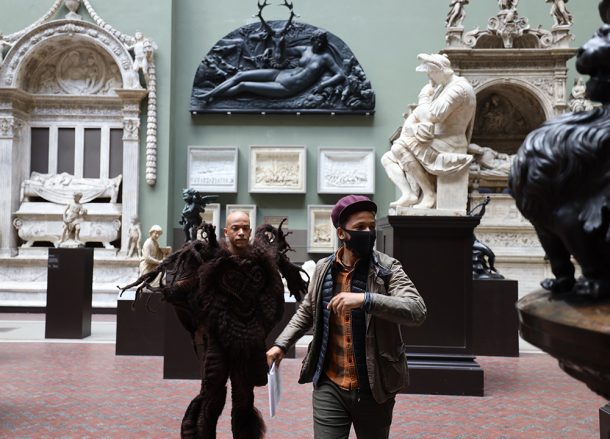
Is there anything that particularly influences your ideas?
I’m interested in using culture as a tool. Usually cultures evolve out of a need for something, and I like what they enable us to do. If I see a need – and that might be a social need, or an ideological need or whatever, I like to create an object, ritual, story or mythology that will help us navigate it.
What is the story that Bring Me To Heal tells?
It starts off with a guy in the museum, and you don’t quite know why he’s there. He doesn’t look like a member of staff and there’s no one else around, so you assume he’s snuck in. It seems like he could be homeless or nomadic.
He’s walking through the museum and comes across a garment made entirely of hair, and it’s like he recognises and respects it – as though that’s what he came for. He whispers into it, the garment comes alive and this completely innocent elemental deity-like character appears in it, like they’ve just been born.
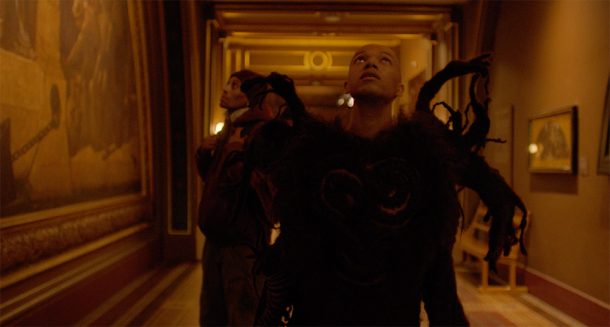
They walk around the museum thinking about how incredible humanity is, looking at all the amazing things people have made. The elemental figure (played by my brother Solomon) wonders at all these objects, but when they get into the Raphael Cartoon Court – a cathedral-like beautiful room – he’s drawn to the beautiful golden altarpiece like a moth to a flame.
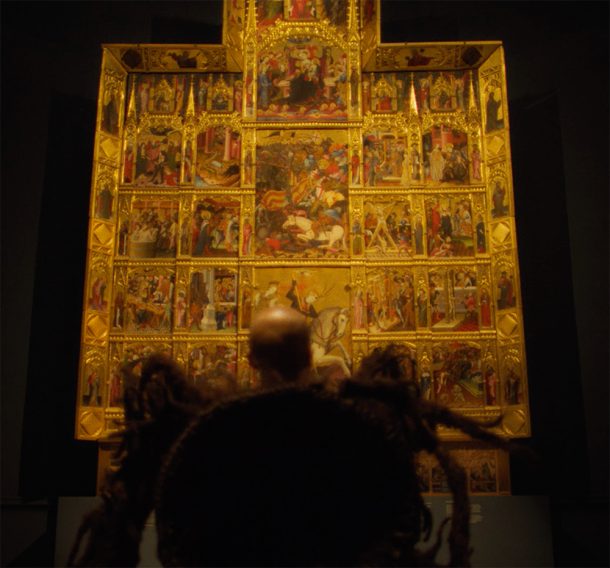
The nomadic figure seems worried – he knows something we don’t, and it turns out that this is the Altarpiece of St George, the patron saint of England, whose cross the English flag is derived from. The elemental character is attracted to the gold and wealth, and as he looks closer, he sees the torture that St George undergoes, and the Christian armies invading and crusading. It’s so gruesome that deity-like Solomon is side-lined and has a breakdown at all this violence because he’s so innocent and naïve. I guess he feels co-opted, thinking ‘wow I was celebrating this, and now look’.
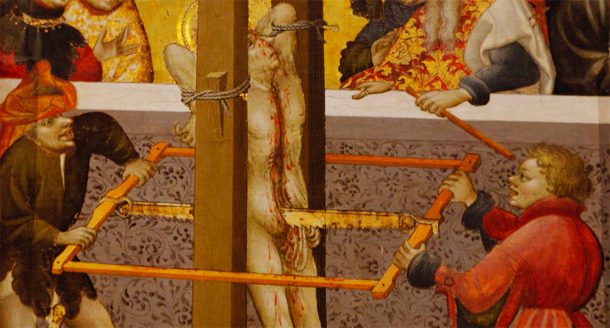
After seeing the violence, he transforms. His innocence has been taken away and you question whether he’s now vengeful. Does he want to put a stop to it? Or is he infected by it? Who knows – but he’s been transformed and maybe not for the better. As he walks out of the gallery, he doesn’t look at any of the objects again, but you can see the objects looking on at him, and all the torturous, scary things become apparent. It’s like he views the world through a completely different lens.
What does the film explore more widely?
Bring Me To Heal looks at my ancestry. I’m mixed race – my Mum is half White Scottish and half White English, and my dad is Ghanaian, but I was raised as a Rastafarian by my Mum and my Jamaican Stepfather, and so I’ve got different cultural influences. As a Rastafarian you learn a lot about trauma and postcolonialism relating to the British empire and slavery, so you see how those things impact you across generations. Even though you might not experience it directly, there are so many things that your parents, grandparents and so on inherited and had to learn, and that get passed down to you, whether you like it or not. So, there can be a lot of deep traumas – these things that they might not want, but subconsciously come out, and you observe that. I’ve been really interested in ancient British history and using the same logic I learnt from my African side of looking at how trauma generationally gets passed down, and applying that thinking to Britain. How things can manifest themselves in violent or problematic behaviours that exist because they’re unresolved and unhealed.
When I was a kid, my mum was a historian, and my earliest memories were going to SOAS (the School of Oriental and African Studies) with her, and learning about African history. She was also really interested in ancient Britain, so we used to go down to Glastonbury and learn about the druids and the pagans, which made me feel this parallel between ancient Britain and Africa. As I grew up I started to identify and learn that I was mixed race, and that I’m not black – that I have white ancestry and that’s also part of who I am. I need to look at Britain as a ‘we’, rather than ‘they’ or ‘this country’, because it is me, and it’s my ancestry as well.
Where did the inspiration for the film come from and how does it tie into the theme of trauma?
One of the symbols in the film and on the garment is the Uffington White Horse which is an ancient monument just outside of Oxfordshire that was carved into the hillside and filled with chalk. It’s part of the inspiration for a story I developed – kind of like a parable – called The Running Horse and the Goose. It became a way for me to draw parallels between Ghana and ancient Britain, because they both passed down stories orally. I feel like there’s been a problem with the way we understand ourselves regarding competition and dominion – that someone’s either winning or losing, and I wanted to see a new way for us to relate to each other and understand ourselves.
The story follows a white horse that won’t stop running. It runs through a group of animals and throws the goose and its family up in the air. The goose gets tangled in its mane and is dragged off, and while he’s on the horse’s back he can’t understand why the horse isn’t sleeping or eating – instead he’s just running. Whenever the goose asks the horse what’s going on, he replies ‘if they don’t run, they get run down’. This carries on for hundreds of years and eventually the horse’s feet can’t take any more and fall off. The same happens with the legs and body, until the horse is just a head lying on the ground. By this point, the goose can’t remember how to walk or how to fly – his whole life has gone. He tries to reason with the horse, but he still says ‘if I don’t run I’ll get run down’. The goose realises that the horse wasn’t running and killing and trampling these animals because he wanted to – he was doing it because he felt that if he didn’t, then something was going to get him.
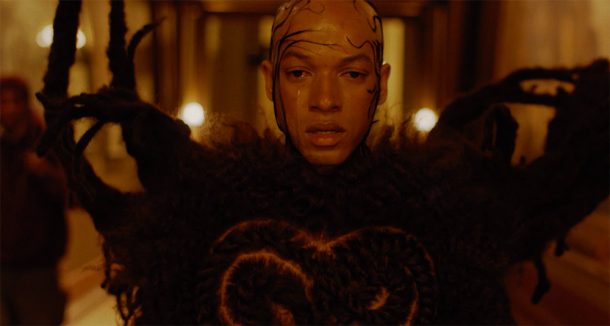
It’s an idea around how we approach things. As society and as individuals it feels that we’re not enough if we don’t do better, if we don’t make more money, if we don’t do more work – we inherit this culture of having to always be better and more advanced. Ultimately it’s unsustainable and just destroys us and those around us. By this point, the goose could suffocate the horse and the power could change. But he decides to nurture the horse by putting it in an egg and teaching it about life. The other animals think the goose should stomp on the egg, but he decides that it’s not his place to do that. He lets it rebuild itself, cracks the egg and lets the horse out. Maybe the horse repeats the past and does it all over again, or maybe he learns from it – and that’s all he needed in the beginning. At the start there was an original trauma that we didn’t know about, that set him on this path. I feel like that parallels the original traumas that we’re all dealing with as a culture and as individuals, that we need to acknowledge. The role of the goose is that it represents this optimistic idea that there is a different way for us to approach trauma – that we don’t always have the answers, but we can find a way.
The garment made from human hair is incredibly striking. Can you tell us about the piece itself and its detailing?
The garment mixes my African heritage – afro hair, dreadlocks and Rastafarianism. Hair is a particularly significant carrier of culture and this need for it to be regularly cared for and looked after is echoed in the title of the work, along with the desire to be brought to the point of healing. Integrating that into the garment was massive. The braided body art on the garment is from ancient Britons – Britain itself was once called Pritanī, which means ‘the painted ones’ or ‘the tattooed folk’ and the paintings represented people’s ideologies and spiritual beliefs. It’s similar to the cultures that Britain ended up colonising and stamping out, and when people look at that garment, they probably wouldn’t think it’s talking about Englishness. I’m really interested in what we’ve forgotten about ourselves. Usually, we feel like African and British cultures are so different, but actually there’s a lot of similarities in things that have happened here and there, and this is just a way for me to explore that connection. Mixing the ancient British and ancient African together and seeing what they make – these powerhouses of culture together in an object.
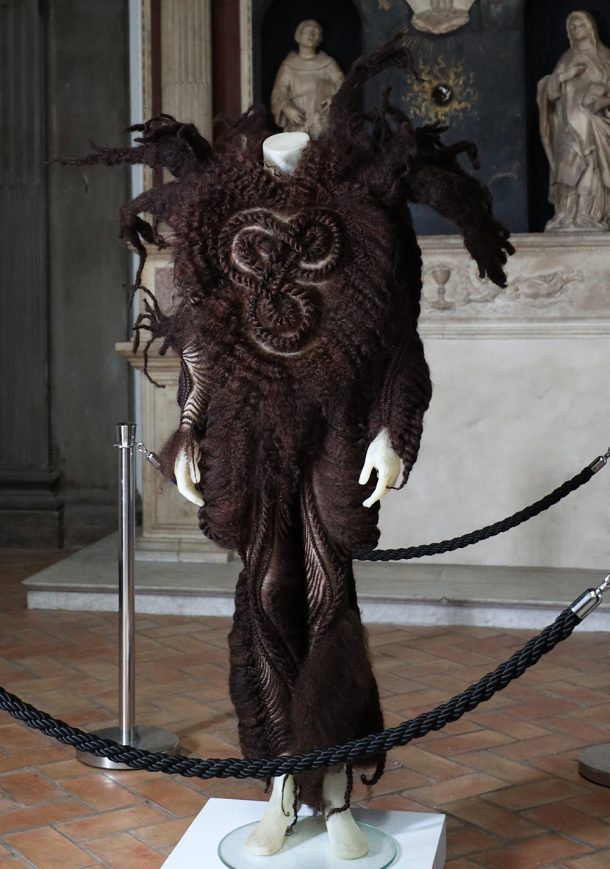
What was the making process like?
Kevin Fortune (the hair artist that plaited, braided and worked the entire garment) originally thought that it’d take us four days to make the whole thing – but it took us three days to just comb it all out! In the end it took us at least four months day and night to plait the whole thing. Every hair was put in by hand by these incredible wig makers at the Shepperton Wig Company that had never done anything like it and had never seen anything like it. We all did something together that we couldn’t have done alone.
The process of making and the nurturing that the garment went through whilst knotting and plaiting took months, and that’s the kind of primal care that I think the nation needs. We need to be nurtured, to have that space, to take that time and to extend that compassion. But not just with words – we need to truly learn how to help each other understand the things we’ve all gone through. As we made progress, the power of the hair and that line between wildness and tameness was so interesting. That that’s where the power was. What’s interesting too is that it’s 100% human hair, so there are people alive today, and maybe some people that are dead, whose hair is in this. There are hundreds of people in that garment.
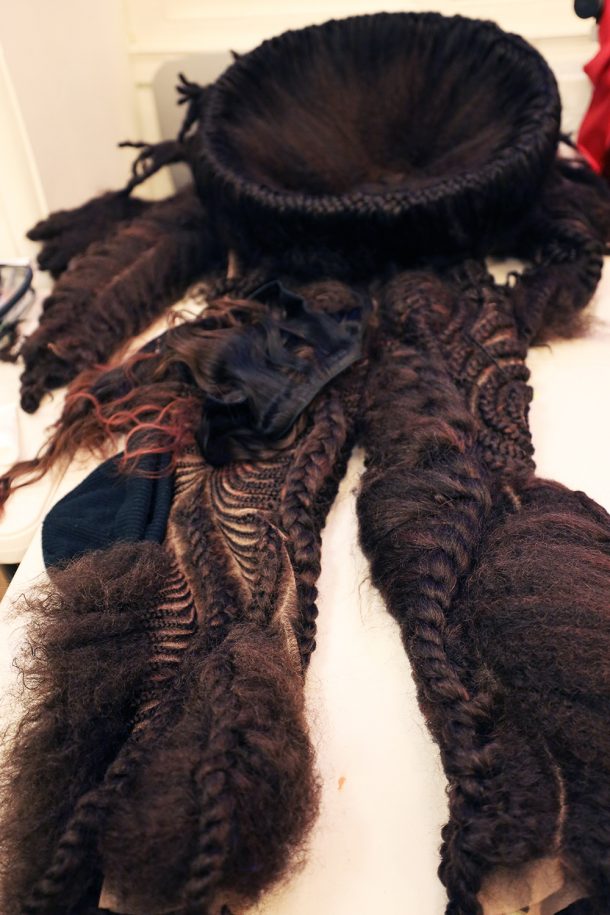
Can you tell us about the significance of the music?
We edited the song a little to fit the beats of the film. As the elemental character is leaving at the end, there’s one bit that we cut to be repeated. The singer Suga Bang Bang is talking about advice from his Grandad, saying ‘don’t move too fast’. Earlier in the film the whole verse says words to the effect of ‘don’t move too fast, this crazy world that you’re living in doesn’t understand’. For me, that’s linking back to the story of the goose and the horse – the singer pleading with Solomon not to start running like the horse did. It’s repeated just at that moment where he decides to go somewhere and take action – so does he try to heal? He’s got the nomadic character (the goose) with him. Does he go out on a rampage to get revenge? Or does he change and transition?
For me that moment is asking myself and us as a nation – what do we do? We’re at this important point with women’s rights, Black Lives Matter – everything. We’re realising that we can’t avoid how we have been anymore. What direction to we go in? How do we deal with it? Do we deal with these issues with compassion and realise we all need healing? Do we deny it? Do we continue it? So I feel like Solomon as the elemental being represents that moment and that question – where are we? What do we want to do as a nation? And how do we want to handle this? In that last scene anything could happen.
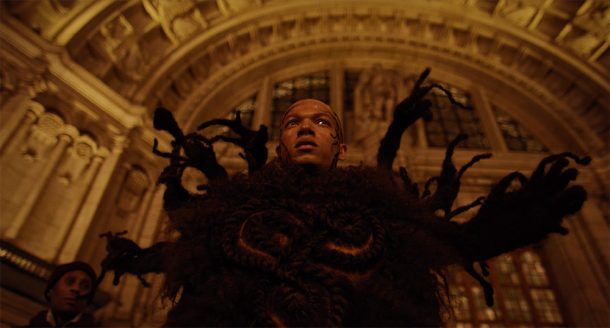
Stay tuned for the next Friday Late. Keep up to date by joining our mailing list.


